
Osmosis is the movement of a thinner liquid into a thicker liquid through a semipermeable partition or membrane when physical external pressure is applied. The thinner liquid dilutes the thicker solution.
Osmosis is a process that occurs in our bodies all the time. For example, after the food we eat is broken down in the stomach, it passes through the intestines. The intestines contract to force the nutrients, which are thinner, to pass through the walls of the intestines into the blood, which is a thicker solution.
In reverse osmosis, exactly the opposite happens. Water that has a high concentration of impurities is put under pressure and forced through a semipermeable partition leaving all the larger particles behind. This process renders the impure water as well as salty water (here the process is called desalination) potable enough to drink.
This is why RO is used in water purifiers. In a purifier, water passes through several stages-a sediment filter, activated carbon filter and ultraviolet light. RO is the final stage. The larger molecules cannot pass through these various filters and RO removes the harmful particles, metal ions and bacteria in the water that remains. This cleans the water thoroughly and prevents diseases caused by contaminated water.
Reverse osmosis is also used in the food industry to make concentrated juices. The traditional heat treatment reduces the quality of heat-sensitive fruits such as oranges. RO reduces the quantity of water in the juice, so it doesn’t need to be thickened by heating. For instance, in the production of maple syrup, RO is used to remove the water from the sap before it is boiled into a syrup. Dairy industries use RO to make concentrated milk and whey protein powders.
Since RO units are also manufactured in compact sizes, they can be installed easily which is why a number of home water filters come equipped with it.
RO removes almost all the minerals in the water, which leaves it tasteless. Some RO systems come with a remineralisation filter that adds minerals to the water and makes it more flavourful!
Picture Credit : Google





